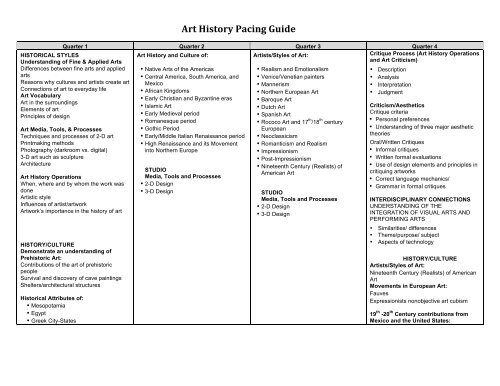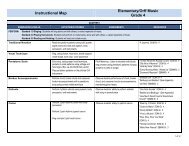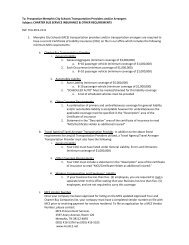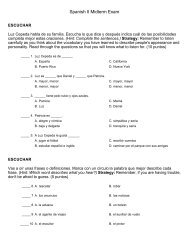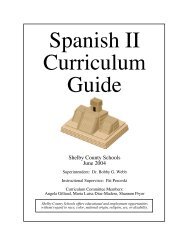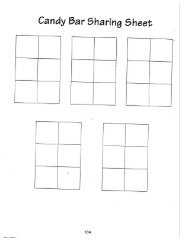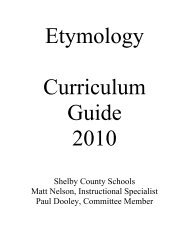Art History Pacing Guide - SCS Home Page
Art History Pacing Guide - SCS Home Page
Art History Pacing Guide - SCS Home Page
Create successful ePaper yourself
Turn your PDF publications into a flip-book with our unique Google optimized e-Paper software.
<strong>Art</strong> <strong>History</strong> <strong>Pacing</strong> <strong>Guide</strong><br />
Quarter 1 Quarter 2 Quarter 3 Quarter 4<br />
HISTORICAL STYLES<br />
Understanding of Fine & Applied <strong>Art</strong>s<br />
• Differences between fine arts and applied<br />
arts<br />
• Reasons why cultures and artists create art<br />
• Connections of art to everyday life<br />
<strong>Art</strong> Vocabulary<br />
• <strong>Art</strong> in the surroundings<br />
• Elements of art<br />
• Principles of design<br />
<strong>Art</strong> Media, Tools, & Processes<br />
• Techniques and processes of 2-D art<br />
• Printmaking methods<br />
• Photography (darkroom vs. digital)<br />
• 3-D art such as sculpture<br />
• Architecture<br />
<strong>Art</strong> <strong>History</strong> Operations<br />
• When, where and by whom the work was<br />
done<br />
• <strong>Art</strong>istic style<br />
• Influences of artist/artwork<br />
• <strong>Art</strong>work’s importance in the history of art<br />
HISTORY/CULTURE<br />
Demonstrate an understanding of<br />
Prehistoric <strong>Art</strong>:<br />
• Contributions of the art of prehistoric<br />
people<br />
• Survival and discovery of cave paintings<br />
• Shelters/architectural structures<br />
Historical Attributes of:<br />
• Mesopotamia<br />
• Egypt<br />
• Greek City-States<br />
<strong>Art</strong> <strong>History</strong> and Culture of:<br />
• Native <strong>Art</strong>s of the Americas<br />
• Central America, South America, and<br />
Mexico<br />
• African Kingdoms<br />
• Early Christian and Byzantine eras<br />
• Islamic <strong>Art</strong><br />
• Early Medieval period<br />
• Romanesque period<br />
• Gothic Period<br />
• Early/Middle Italian Renaissance period<br />
• High Renaissance and its Movement<br />
into Northern Europe<br />
STUDIO<br />
Media, Tools and Processes<br />
• 2-D Design<br />
• 3-D Design<br />
<strong>Art</strong>ists/Styles of <strong>Art</strong>:<br />
• Realism and Emotionalism<br />
• Venice/Venetian painters<br />
• Mannerism<br />
• Northern European <strong>Art</strong><br />
• Baroque <strong>Art</strong><br />
• Dutch <strong>Art</strong><br />
• Spanish <strong>Art</strong><br />
• Rococo <strong>Art</strong> and 17 th /18 th century<br />
European<br />
• Neoclassicism<br />
• Romanticism and Realism<br />
• Impressionism<br />
• Post-Impressionism<br />
• Nineteenth Century (Realists) of<br />
American <strong>Art</strong><br />
STUDIO<br />
Media, Tools and Processes<br />
• 2-D Design<br />
• 3-D Design<br />
Critique Process (<strong>Art</strong> <strong>History</strong> Operations<br />
and <strong>Art</strong> Criticism)<br />
• Description<br />
• Analysis<br />
• Interpretation<br />
• Judgment<br />
Criticism/Aesthetics<br />
Critique criteria<br />
• Personal preferences<br />
• Understanding of three major aesthetic<br />
theories<br />
Oral/Written Critiques<br />
• Informal critiques<br />
• Written formal evaluations<br />
• Use of design elements and principles in<br />
critiquing artworks<br />
• Correct language mechanics/<br />
• Grammar in formal critiques<br />
INTERDISCIPLINARY CONNECTIONS<br />
UNDERSTANDING OF THE<br />
INTEGRATION OF VISUAL ARTS AND<br />
PERFORMING ARTS<br />
• Similarities/ differences<br />
• Theme/purpose/ subject<br />
• Aspects of technology<br />
HISTORY/CULTURE<br />
<strong>Art</strong>ists/Styles of <strong>Art</strong>:<br />
• Nineteenth Century (Realists) of American<br />
<strong>Art</strong><br />
Movements in European <strong>Art</strong>:<br />
• Fauves<br />
• Expressionists nonobjective art cubism<br />
19 th -20 th Century contributions from<br />
Mexico and the United States:
• Greek and Roman <strong>Art</strong> and Architecture<br />
• India<br />
• China<br />
• Japan<br />
STUDIO<br />
Media, Tools and Processes<br />
2-D Design:<br />
• Media, tools, processes and techniques<br />
• Style, theme, time period<br />
3-D Design:<br />
• Media, tools, and processes<br />
• Style, theme, time period<br />
• Mexican muralist<br />
• Armory Show of 1913<br />
• Ashcan School of art<br />
European and American Architecture:<br />
• Contributions of Alexandre Gustave Eiffel<br />
and Antonio Gaudi<br />
• Eclectic style of architecture in US<br />
• Style of Louis Sullivan<br />
Revolutions in European and American<br />
<strong>Art</strong>:<br />
• Dada<br />
• Surrealism<br />
• fantasy<br />
• Regionalism<br />
Contemporary 20 th Century <strong>Art</strong>/<strong>Art</strong>ists<br />
Movements:<br />
• Abstract expressionism<br />
• pop-art<br />
• op-art<br />
• hard-edge painting<br />
• photo-realism<br />
Innovations in Sculpture and<br />
Architecture:<br />
• Nonobjective <strong>Art</strong> by 20 th century sculptors<br />
• Post-modern architecture/architects<br />
DIGITAL ART FORMS<br />
• Analog vs. Digital<br />
• Photography<br />
• Video<br />
• Digital Software<br />
• Animation<br />
CAREERS IN ART<br />
STUDIO<br />
Media, Tools and Processes<br />
• 2-D Design<br />
3-D Design


